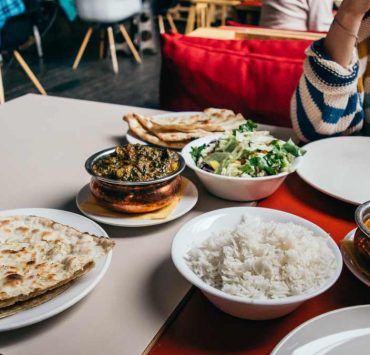While many Hungarian dishes are based on meat, bread and seasonal vegetables, travellers are surprised to find so many more interesting and tasty dishes on the menu.
Due to its background, Hungary exhibits a heavily Germanic-influenced cuisine, albeit with its own distinctive Magyar spin. So, if you’re heading on a trip to Budapest and/or the Hungarian countryside, here are a few of the tempting foods you should try — even if you can’t pronounce the names!
Lángos
This is undoubtedly one of the unhealthiest fast-food options on the planet — but it’s sooo good! Lángos is especially delicious after a late night out. The base consists of a deep-fried dough, on which you can put a variety of toppings, the most popular of which is sour cream and cheese. Other options include mashed potatoes, yogurt, mushrooms, cabbage or even jam. Visitors from the American Southwest may recognize the base as a variant of Indian frybread. Your arteries may clog, but your taste buds will thank you.
A bejegyzés megtekintése az Instagramon
Gulyás
Commonly known to foreigners as goulash, Gulyás is a traditional beef stew that has served as a staple of the Hungarian diet since the ninth century. Of course, in Hungary it is more of a soup than a stew and is often served with csipetke (egg noodles). Gulyás comes in many different forms and other countries throughout Central and Eastern Europe have their own national variants. Popular Hungarian goulashes may include beans, sauerkraut, smoked meat, potatoes or sour cream.
Pörkölt
Although foreigners sometimes confuse it with Gulyás, Pörkölt is a different kind of meat stew, consisting of meat (mostly beef and pork), paprika and a variety of vegetables. In country pubs and more other traditional venues, you may often find it made with venison or other game meats. Along with Gulyás and Paprikás, it is one of the national dishes of Hungary.
A bejegyzés megtekintése az Instagramon
Dobos Torte
This Hungarian specialty is an intricate five-layered cake of chocolate buttercream and sponge. It’s topped with a glorious crunchy crust of caramel and decorated with nuts along the side. This elegant torte, developed in 1885, is popular at upscale restaurants and pastry shops around Europe, but is definitely one of the desserts in which you have to indulge in Hungary.
A bejegyzés megtekintése az Instagramon
Rántott Sajt
Also popular in Czech Republic and Slovakia, Rántott Sajt is basically deep-fried cheese. Battered in breadcrumbs and typically consisting of edam, mozzarella or a local cheese, this unhealthy yet irresistible dish is commonly served as a street snack. How ever did those Gabor sisters keep so svelte?
A bejegyzés megtekintése az Instagramon
Gombóc
Gombóc is another type of dumpling, similar to those found all over Central and Eastern Europe. It’s made from potato dough filled with plums, rolled into balls and boiled. Then, for good measure, it is sprinkled with bread crumbs. For a final flourish, these babies are dolloped with sour cream and sprinkled with cinnamon sugar. Savory varieties exists as well, but the dessert Gombóc is divine – never mind the calories.
A bejegyzés megtekintése az Instagramon
Kolbász
Kolbász generally translates into sausage and Hungarian variants feature a distinctive and unique flavor, largely due to the paprika content. The most popular version in Budapest is the Gyulai kolbász, a slow-cooked, wood-smoked pork sausage which is typically served with bread or used in stews. Another popular choice is Csabai kolbász, a spicier option. Hungarians pride themselves on their sausages, so add Kolbász to your list of must-try foods in Hungary.
A bejegyzés megtekintése az Instagramon
Kürtőskalács
One of Hungary’s two favorite sweets, and popular throughout the country, kürtőskalács is a sweet snack typically served on the street, particularly during festivals. It is made from a sweet yeast dough which is spun around in the shape of a cone before being rolled around in sugar and baked over charcoal. The sugar helps to form a crispy, caramelized crust for some truly sugary decadence.
A bejegyzés megtekintése az Instagramon
Halászlé
Halászlé loosely translates as fisherman’s soup, and it is found all over Hungary and the Balkan countries. It is a spicy soup containing freshwater fish, typically carp, and an abundance of paprika; Hungarians do so love their paprika. It is one of the spiciest dishes of all Hungarian cuisine. Loved by both tourists and locals alike, there are several common variations, including one that uses four types of river fish.
A bejegyzés megtekintése az Instagramon
Főzelék
Those wanting a break from the meat and dough dishes that Hungary typically has to offer should try főzelék, a thick vegetable stew (finally, some healthy veggies!). But take note: it may sometimes come with a small amount of sausage or meatballs. A commonly homemade food, it can contain kale, lentils, beans, potatoes, bell peppers, cabbages, sauerkraut and a wide variety of other local produce.
Palacsinta
Palacsinta are similar to crêpes and made primarily from eggs, milk and wheat flour. In Hungary, they come in both sweet and savory varieties. Desserts are traditionally rolled in plum, strawberry or apricot jam or a sweet cottage cheese before being sprinkled with sugar. Another popular option includes walnuts, raisins and orange peel. Palacsinta may also be served as a main course, filled with vegetables, mushrooms or meat. This is definitely one of the foods you must try in Hungary.
A bejegyzés megtekintése az Instagramon




